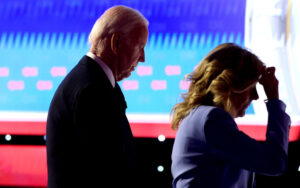In the summer of 1924, the Democratic Party gathered in New York City for what turned out to be one of the ugliest conventions in US history. It not only revealed the fractures within the party, but also those in the country as a whole: animosity and mistrust along the lines of race, ethnicity, religion, culture and ideology cast a shadow on American politics then, as they do now. And yet, despite it all, this historical moment showed that Americans on opposing sides could still come together and realise a common destiny.
The episode is particularly poignant today, in the aftermath of the attempted assassination of Donald Trump, when it appears as if the very life and unity of the republic is on the line. In light of this, 1924 offers a parable not just for Democrats but for Republicans and, indeed, all Americans, who may be interested in taking the longer-term view and envisioning how the nation might get through this darkly ominous season of disunity.
During the Twenties, the Republicans were the party of the “ins”, uniting financial and industrial interests centred in the Northeast with well-to-do farmers, professionals and businessmen from most of the rest of the country, outside the South. The election of 1920 saw the triumph of the Republicans under Warren Harding after the Wilson interlude and the First World War.
The states of the old Confederacy voted against Republicans not just out of post-Civil War bitterness but because their region had been reduced to an economic backwater, left out of the industrial development that transformed the North and consigned to be its captive market. The fact that Southern elites retained the racial hierarchy of Jim Crow on top of a half-feudal agrarian economy based on exploitation of ex-slaves and poor whites alike did not help. And for these reasons, they, along with some of the similarly underdeveloped regions in the Western periphery, saw themselves as outcasts and opponents of Northeastern capital, and were thus Democrats.
But they were not the only segments of the country with an axe to grind. The industrial working class in many big Northern cities suffered from the effects of a highly unequal economy: shabby tenements, low wages and poor working conditions. This united them with the hinterlands and cemented Democrats as the party of the “outs”. There was, however, one problem: the ranks of the urban classes were swelled by immigrants and their children, many were Catholic or Jewish and, if not Irish, came from even more alien south and east European cultures. Meanwhile, the American South and West were — just like their Northern rivals — overwhelmingly Anglo-Protestant and were susceptible, to say the least, to xenophobic and anti-Catholic prejudice.
It’s worth mentioning that the debacle of 1924 took place before cultural affinities became the main criterion for party affiliations, as it is today. This meant that parties, the Democrats in particular, could hold constituencies with radically opposed views on identity or morality (“culture war issues”) as part of the same electoral coalition.
The intra-Democrat divide set the stage for the 1924 showdown at Madison Square Garden, to select a challenger to Harding’s successor, Calvin Coolidge. The two frontrunners were Governor Al Smith of New York and Senator William Gibbs McAdoo of California. The Irish-Italian Smith was a tribune of the urban proletariat, having risen from humble origins to become a forceful advocate for progressive reforms in state government. He had been supported by New York City’s Tammany Hall machine. McAdoo was a financial technocrat, originally from Tennessee, who presided over the opening of the Federal Reserve as Treasury Secretary under his father-in-law Woodrow Wilson. Working for his candidacy — though he could not acknowledge it — was the Ku Klux Klan.
The tragedy was that Smith’s and McAdoo’s overlapping reformist tendencies could not coalesce into a coherent platform due to the enmity of their bases. Instead, they duelled over Prohibition and an anti-Klan plank. The proceedings were marred by violence between Tammany toughs and Klansmen; the nomination process stretched out across 103 gruelling ballots over 16 days. American journalist H.L. Mencken described it as “3,000 dogs in one great pit, all frantically chasing their tails”.
The announcement of a winner was as anticlimactic as it was fatal to the Democrats’ chances in the November election: stalemated delegates settled on John W. Davis, a lawyer from West Virginia, who shared neither Smith’s nor McAdoo’s talents. There was no coming together and predictably, the Democrats suffered a landslide defeat to the Coolidge Republicans, earning only 29% of the popular vote and securing only 12 states, all in the South. Intra-party tribalism persisted until the next election in 1928, when Smith won the nomination, and several ex-Confederate states bolted for the Republican candidate Herbert Hoover, rather than vote for a Catholic.
In the end it took a crisis, namely the Crash of 1929, to weld Democrats back together in time for 1932. That year’s nominee was the man who introduced Smith as “the Happy Warrior” in 1924. Franklin D. Roosevelt did what his predecessor could not: unite the industrial working class with the hinterlands under the banner of the New Deal, despite their lingering hatreds. FDR’s administration granted relief and employment to workers at the same time as it subsidised development of the South and West. Compromises were struck, however, with respect to racial equality and labour unions in the South, whose reactionary culture could not yet countenance the pace of change (leaving it to a later era to enact Civil Rights).
But the economy sprung back into production: workers of all races and creeds as well as the backwater regions saw living standards improve from the depths of the Depression, though it took the Second World War to consolidate this progress. While McAdoo remained a Roosevelt partisan, Smith became a fierce critic, never acknowledging that the New Deal’s success rested on foundations he and his convention rival had jointly laid: its welfare-developmental state was a synthesis of their best instincts.
This optimistic moment in US history illustrates that seemingly intractable resentments between feuding tribes can be overcome by a shared agenda of sweeping material reform and renewal. But how could such a blueprint possibly be applied to today’s divided America?
It’s important to remember that beneath the “friend-enemy” tribalism that’s taken hold, the two parties are still coalitions of interests. The upheavals of both the post-2016 Right and Left stem, not so much from the working class, but from the anxieties of two rival “subaltern elites”: the small-business “gentry” class which presides over struggling de-industrialised hinterlands (not unlike the places represented by McAdoo); and the downwardly mobile professional managerial classes or “clerisy” who live in the major urban metropoles (not unlike the places represented by Smith).
Both of these factions hold outsize influence within their parties; both led the turn away from neoliberalism. And the outline of a programme to unite them has become evident in recent years. Bidenomics is, after all, the Democrats’ adaptation of the same criticisms against globalisation levelled by Donald Trump in 2016, while populist Republicans in the Senate have developed their own industrial policies closer in spirit to what the Democrats are doing than the tax cuts and austerity proposals still officially favoured by their party leadership.
A programme of industrial redevelopment would benefit both the clerisy and the gentry: the former from the expansion of demand for managerial talent that would come with decentralisation of economic activity away from bloated prestige sectors such as finance and tech; the latter from the capital that reshoring would bring to the left-behind regions which they preside over as local elites. It would create jobs for the working class as well. That the Democrats’ national industrial policies are leading to increased investment in low-regulation, Republican-voting districts is already a sign that such a non-zero-sum modus vivendi is plausible, if the political incentive isn’t to constantly self-polarise, as Smith and McAdoo did.
What’s needed is firstly a positive vision around which the tribes can coalesce. If that doesn’t work, a period of emergency, like that of 1929-1945 may do the trick. A Chinese invasion of Taiwan and seizure of its chip industry, with all the major geopolitical and economic implications this would have for America, could be the impetus that finally brings these brawling groups together.
This is all supposing that Americans can put aside their differences, as Smith’s and McAdoo’s factions eventually did, in pursuit of something larger than themselves. This is a decade-long bet: the short-term outlook is admittedly grimmer, for the country has to stay together long enough to mount such reforms and the tensions currently on display are about as toxic as they were 100 years ago. But with an eye to the future and confidence in themselves, Americans must recognise: the only way out is through.
Disclaimer
Some of the posts we share are controversial and we do not necessarily agree with them in the whole extend. Sometimes we agree with the content or part of it but we do not agree with the narration or language. Nevertheless we find them somehow interesting, valuable and/or informative or we share them, because we strongly believe in freedom of speech, free press and journalism. We strongly encourage you to have a critical approach to all the content, do your own research and analysis to build your own opinion.
We would be glad to have your feedback.
Source: UnHerd Read the original article here: https://unherd.com/




